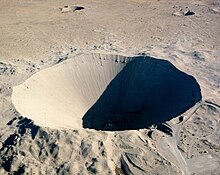MURDER, POLITICS, AND THE END OF THE JAZZ AGE
by Michael Wolraich
Order today at Barnes & Noble / Amazon / Books-A-Million / Bookshop

|
MURDER, POLITICS, AND THE END OF THE JAZZ AGE by Michael Wolraich Order today at Barnes & Noble / Amazon / Books-A-Million / Bookshop |

I just added Operation Plowshare to the long list of stuff I never knew about.
Following links, I ended up at 1967 Recklessness in PA Equals Destruction? at How Should We Do the Mountain blog:
In hindsight, the plan seems impossibly audacious: Explode a 24-kiloton atomic bomb in the thick shale beneath the Sproul State Forest near State College to create a massive cavern for storing natural gas. Known as Project Ketch, it was a partnership between the Columbia Gas System Service Corp. and the U.S. Atomic Energy Commission, which was hungry to find peaceful purposes for nuclear technology. (Another commission brainchild of the era: to nuke its way across Panama to create a second canal.)
Back then, Harrisburg had the red carpet out for any nuclear project, no matter how bizarre, and the proposal caught on. Why not put all that empty forest land to good use? Pennsylvania could cash in big, because the industry and the AEC hoped to detonate as many as 1,000 nuclear bombs to allow gas storage in the Northeast.
While the plan had the blessing of lawmakers from downstream districts along the Susquehanna, the reception wasn’t as enthusiastic upstream. Among those opposed were the residents of Renovo, which was ground zero for Project Ketch.
I've been to Renovo. Back in the 1990s, my old choir took a bus North to sing a mass at St Joseph. Afterwards I asked a congregant what drove the local economy. "Railroad retirement," he said. Conrail, and its predecessors, were no longer major employers in the area, so most of the people that lived there—doctors, veterinarians, shop clerks—served the needs of retired railroad workers.
I suppose almost any industry would be attractive to those who were watching their sources of income age up and pass on. But not nuclear bombs. Local outcry killed the project in Pennsylvania, but it was tried in Colorado, as described in the wikipedia link above:
The final PNE [Peacetime Nuclear Exercise] blast took place on 17 May 1973, under Fawn Creek, 76.4 km north of Grand Junction, Colorado. Three 30 kiloton detonations took place simultaneously at depths of 1,758, 1,875, and 2,015 meters. It was the third nuclear explosion experiment intended to stimulate the flow of natural gas from "tight" formation gas fields. ...
If it was successful, plans called for the use of hundreds of specialized nuclear explosives in the western Rockies gas fields. The previous two tests had indicated that the produced natural gas would be too radioactive for safe use. After the test it was found that the blast cavities had not connected as hoped, and the resulting gas still contained unacceptable levels of radionuclides.[4]
... the concept that stove burners in California might soon emit trace amounts of blast radionuclides into family homes did not sit well with the general public. The contaminated well gas was never channeled into commercial supply lines.
The radioactive blast debris from 839 U.S. underground nuclear test explosions remains buried in-place and has been judged impractical to remove by the DOE's Nevada Site Office.
The situation remained so for the next three decades, but a resurgence in Colorado Western slope natural gas drilling has brought resource development closer and closer to the original underground detonations. By mid-2009, 84 drilling permits had been issued within a 3-mile radius, with 11 permits within one mile of the site.
Operation Plowshare does put hydraulic fracturing in perspective. A government/industry partnership willing to explode nukes to get natural gas isn't going to let a few minor earthquakes and sickened residents stop them.
Update: There have been similar proposals about using nukes to simultaneously expose and heat the kerogen trapped in veins of shale formations in the Western US. I am reminded of all the tv comedy sketches where someone juggles a lit stick of dynamite, then throws it up in the air and covers their ears. After the big noise, they catch a perfectly-browned, cooked duck.
Comments
If you had written that as science fiction, I would've rolled my eyes and called it unbelievably implausible that anyone could be that reckless on such a grand scale.
by Verified Atheist on Mon, 01/23/2012 - 12:23pm
I just can't even fathom an objection to this. It's a wonderful idea and the consequences of anything going wrong seem minimal, if not laughable. I wonder what other kinds of things we can do with very large bombs? This is the future, Donal.
by Michael Maiello on Mon, 01/23/2012 - 1:40pm
Well, there's always this.
by Verified Atheist on Mon, 01/23/2012 - 2:12pm
I was going to convert my car to run like that. Not only would it be fast, it would eliminate all the tailgaters.
by Donal on Mon, 01/23/2012 - 3:54pm
The result of an environmental IMPACT benefits/burdens test might read:
WHAT THE F&%K?
by Richard Day on Mon, 01/23/2012 - 2:18pm